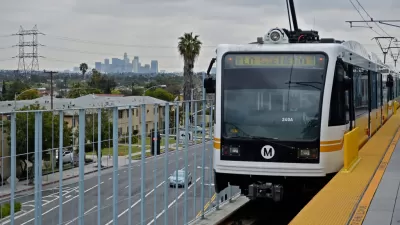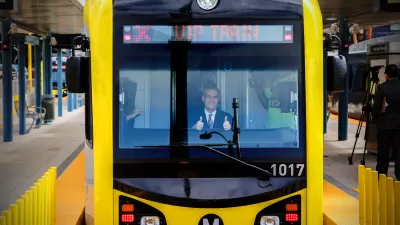Yes, yes. We all want to save the children. They are our most precious resource and hold the key to our future. Let them lead the way, and please, lord, don't let them get run over by a train. Fortunately, most American kids face no such danger because they are held safe in far-flung suburbs where conformity and the cocoon of the strip mall tend to their well-being. They are growing up strong and worldly behind gates and in perfect communities far from the strife of the city, where art, culture, diversity, adventure, and freedom might stimulate them just a little too much.
Yes, yes. We all want to save the children. They are our most precious resource and hold the key to our future. Let them lead the way, and please, lord, don't let them get run over by a train.
Fortunately, most American kids face no such danger because they are held safe in far-flung suburbs where conformity and the cocoon of the strip mall tend to their well-being. They are growing up strong and worldly behind gates and in perfect communities far from the strife of the city, where art, culture, diversity, adventure, and freedom might stimulate them just a little too much.
But those few kids who forage about America's cities -- thanks either to extreme wealth or extreme poverty -- face a new danger, aside from all the others that prompted the middle class to flee in the first place. Never mind crack and gangs and drive-bys and fast food. The newest threat is, of course, light rail: Sleek, refulgent, and, apparently, deadly.
This story could play out anywhere, but it just happens to be in Los Angeles, where the Los Angeles County Metropolitan Transportation Authority has been trying to build an east-west light rail line from Downtown to the ocean since roughly the invention of the wheel. Traffic has finally gotten so bad that two years ago Metro came to its senses and approved the Exposition Line. Community activists had lobbied for it, local officials got on board, and plenty of other folks were thrilled, including the driving public, TOD developers, and, importantly, community members who believe that light rail will benefit the economy of a rough, though emerging, swath of Los Angeles south of the 10 Freeway.
But, of course, no good deed goes unpunished.
The latest country heard from to oppose or otherwise gum up the Expo Line (whose first phase is funded and slated for completion in 2009) are the concerned parents and educators of L.A.'s Dorsey High School, past which the line would run. In a sane world, the co-location of a 4,000-student school and a light rail line would make a lot of sense. Kids could get to school in a safe, cheap, and easy fashion, and a few yellow buses could be retired. Moreover, it's the sort of investment for which inner city neighborhoods clamor; in 1993 Metro's predecessor lost a lawsuit based on the accusation that it had not invested enough in inner city neighborhoods.
But now, fearing untimely conferences between train and child, parents and school officials are demanding a $40 million trench , overpass, or other such folly that would separate tracks from pedestrians. That's $1000 for every student who attends Dorsey for the next 40 years. Imagine what the school could do with that kind of money if the students just pledged to look both ways. (It could start by hiring a crossing guard or two.)
Metro has reached out to the community and launched a consientious public relations and scoping campaign. Metro is working hard to plead a case that should be obvious in L.A., as it is, quite famously, in New Orleans, San Fancisco, and every city in Europe. But the emergence of hundreds of paranoids railing about a false conflict between transit and safety suggests that the planning field still has a long way to go. These days, the most well-laid plans mean nothing unless the public understands their benefit. At Dorsey, it's as if they're doing Metro a favor by letting them run Expo through their community (on a right of way that used to be, of all things, a railroad right of way).
The question, of course, is whether planners need to communicate better -- to "frame" the issues, to borrow the parlance of this decade's Republican juggernaut -- or whether stakeholders need to acquaint themselves with common sense. It's probably a little of both. In this case, if the community wants to invoke their children for the sake of hysteria, so be it. Planners, then, must become as passionate about kids' safety as they are about rail lines.
The task here, though, is not to give in and start revving up the boring machines but rather to use soft power against thick skulls. Metro must hold parents' hands and educate them about the hierarchy of dangers in the urban environment. Obvious to any thinking transportation planner is the fact that light rail will be safer than the status quo because it will take cars off the street. Indeed, nothing is more dangerous than a car (former Bogota Mayor and transit demigod Enrique Penalosa draws a sobering comarison between cars and wolves: the latter, which most of us have never seen, inspires carnal fear while the former, which draws blood daily, runs our lives).
Trains may be big and rumbly, but those parents should be encouraged to contrast a big predictable train with the uninsured nut behind the wheel of the pickup with bald tires, worn brake pads, and a half-smoked joint his glove box. Or they should consider the pollution emitted by that driver and his millions of fellow motorists. (Never mind the Big Macs, booze, reality TV, and other vices with which families of all stripes poison themselves so willingly.)
The public conversation has often allowed us to think of safety and health as separate issues. But they both lead to the same end when the (real) danger from pollution is weighed against the (nearly fanciful) danger of an at-grade crossing. The Expo Line will not, of course, run all of LA's smog out on a rail. But in the aggregate, as public transit catches on as it should, the lives saved by reducing pollution surely will outnumber the lives emperiled when carelessness comes face-to-face with a train.
Finally, there's those darn kids. Parents are afraid that they're going to pull stunts like hurdling crossing gates and playing chicken. Or maybe their iPods will be on too loud for them to hear the train. Though I have full faith in the idiocy of children, I recall a few lessons my parents taught me: look both ways; watch for the light; drivers are idiots. That was enough to teach me to navigate intersections and crossings of all shapes and sizes. Kids in Europe learn the same lessons, except their trains run on the very streets where they walk--not only are the grades not separated, the rights of way aren't separated! If Dorsey High--which, last time I checked, advertises itself as a place of learning -- cannot impart a few simple lessons to its students, then we have far greater problems.
If a small group of extremists wants to rail against the common good, so be it. That's democracy, and common sense is supposed to prevail. But when those opponents are so interested in rabble-rousing that they undermine their own self-interest -- in this case, the very lives of their children -- something is truly amiss.
But this is the paradox that planners face time and again. If planners cannot impart those lessons to the community (and politicians are willing to bend to hysteria), then far more is at stake than a rail line. Indeed, the Expo Line is not a threat to public safety; the real threat is its absence. Without good infrastructure, cities will grow more congested, pollution will rise, and communities will stagnate. Meanwhile, out in the suburbs, ennui and gas prices will continue to take their toll, and parents will continue to congratulate themselves for protecting their children and weakening a city.

Trump Administration Could Effectively End Housing Voucher Program
Federal officials are eyeing major cuts to the Section 8 program that helps millions of low-income households pay rent.

Planetizen Federal Action Tracker
A weekly monitor of how Trump’s orders and actions are impacting planners and planning in America.

Ken Jennings Launches Transit Web Series
The Jeopardy champ wants you to ride public transit.

California Invests Additional $5M in Electric School Buses
The state wants to electrify all of its school bus fleets by 2035.

Austin Launches $2M Homelessness Prevention Fund
A new grant program from the city’s Homeless Strategy Office will fund rental assistance and supportive services.

Alabama School Forestry Initiative Brings Trees to Schoolyards
Trees can improve physical and mental health for students and commnity members.
Urban Design for Planners 1: Software Tools
This six-course series explores essential urban design concepts using open source software and equips planners with the tools they need to participate fully in the urban design process.
Planning for Universal Design
Learn the tools for implementing Universal Design in planning regulations.
Ada County Highway District
Clanton & Associates, Inc.
Jessamine County Fiscal Court
Institute for Housing and Urban Development Studies (IHS)
City of Grandview
Harvard GSD Executive Education
Toledo-Lucas County Plan Commissions
Salt Lake City
NYU Wagner Graduate School of Public Service






























